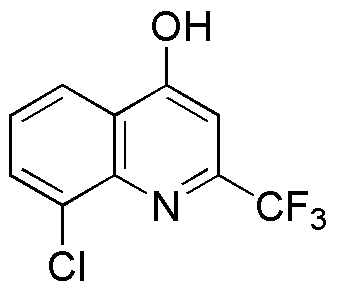8-Chloro-4-hydroxy-2-(trifluoromethyl)quinoline is widely utilized in research focused on:
- Pharmaceutical Development: This compound serves as a key intermediate in synthesizing various pharmaceuticals, particularly in developing anti-inflammatory and antimicrobial agents.
- Agricultural Chemicals: It is used in formulating agrochemicals, including herbicides and fungicides, providing effective solutions for crop protection and yield enhancement.
- Biochemical Research: Researchers employ this compound in studies related to enzyme inhibition and receptor binding, aiding in understanding biological processes and disease mechanisms.
- Material Science: Its unique properties make it suitable for developing advanced materials, such as coatings and polymers, that require specific chemical resistance and stability.
- Diagnostic Applications: The compound is explored in the field of diagnostics, particularly in creating reagents for detecting various biological markers, enhancing the accuracy of medical tests.
General Information
Properties
Safety and Regulations
Applications
8-Chloro-4-hydroxy-2-(trifluoromethyl)quinoline is widely utilized in research focused on:
- Pharmaceutical Development: This compound serves as a key intermediate in synthesizing various pharmaceuticals, particularly in developing anti-inflammatory and antimicrobial agents.
- Agricultural Chemicals: It is used in formulating agrochemicals, including herbicides and fungicides, providing effective solutions for crop protection and yield enhancement.
- Biochemical Research: Researchers employ this compound in studies related to enzyme inhibition and receptor binding, aiding in understanding biological processes and disease mechanisms.
- Material Science: Its unique properties make it suitable for developing advanced materials, such as coatings and polymers, that require specific chemical resistance and stability.
- Diagnostic Applications: The compound is explored in the field of diagnostics, particularly in creating reagents for detecting various biological markers, enhancing the accuracy of medical tests.
Documents
Safety Data Sheets (SDS)
The SDS provides comprehensive safety information on handling, storage, and disposal of the product.
Product Specification (PS)
The PS provides a comprehensive breakdown of the product’s properties, including chemical composition, physical state, purity, and storage requirements. It also details acceptable quality ranges and the product's intended applications.
Certificates of Analysis (COA)
Search for Certificates of Analysis (COA) by entering the products Lot Number. Lot and Batch Numbers can be found on a product’s label following the words ‘Lot’ or ‘Batch’.
Numéro de catalogue
Numéro de lot/série
Certificates Of Origin (COO)
This COO confirms the country where the product was manufactured, and also details the materials and components used in it and whether it is derived from natural, synthetic, or other specific sources. This certificate may be required for customs, trade, and regulatory compliance.
Numéro de catalogue
Numéro de lot/série
Safety Data Sheets (SDS)
The SDS provides comprehensive safety information on handling, storage, and disposal of the product.
DownloadProduct Specification (PS)
The PS provides a comprehensive breakdown of the product’s properties, including chemical composition, physical state, purity, and storage requirements. It also details acceptable quality ranges and the product's intended applications.
DownloadCertificates of Analysis (COA)
Search for Certificates of Analysis (COA) by entering the products Lot Number. Lot and Batch Numbers can be found on a product’s label following the words ‘Lot’ or ‘Batch’.
Numéro de catalogue
Numéro de lot/série
Certificates Of Origin (COO)
This COO confirms the country where the product was manufactured, and also details the materials and components used in it and whether it is derived from natural, synthetic, or other specific sources. This certificate may be required for customs, trade, and regulatory compliance.


